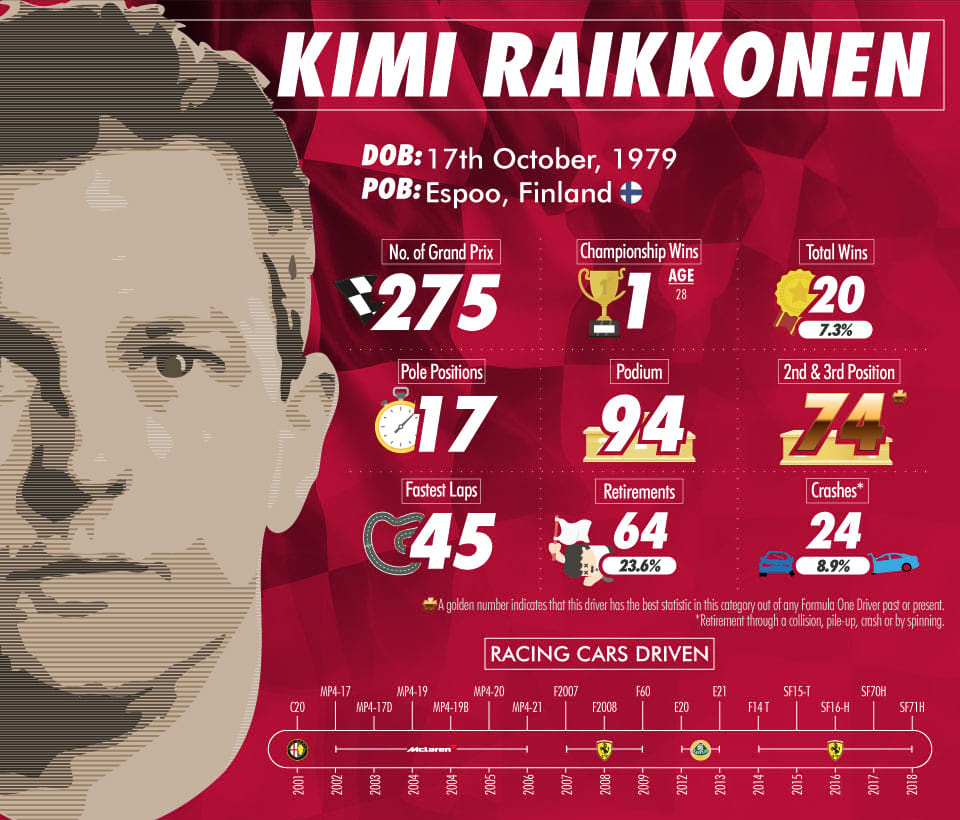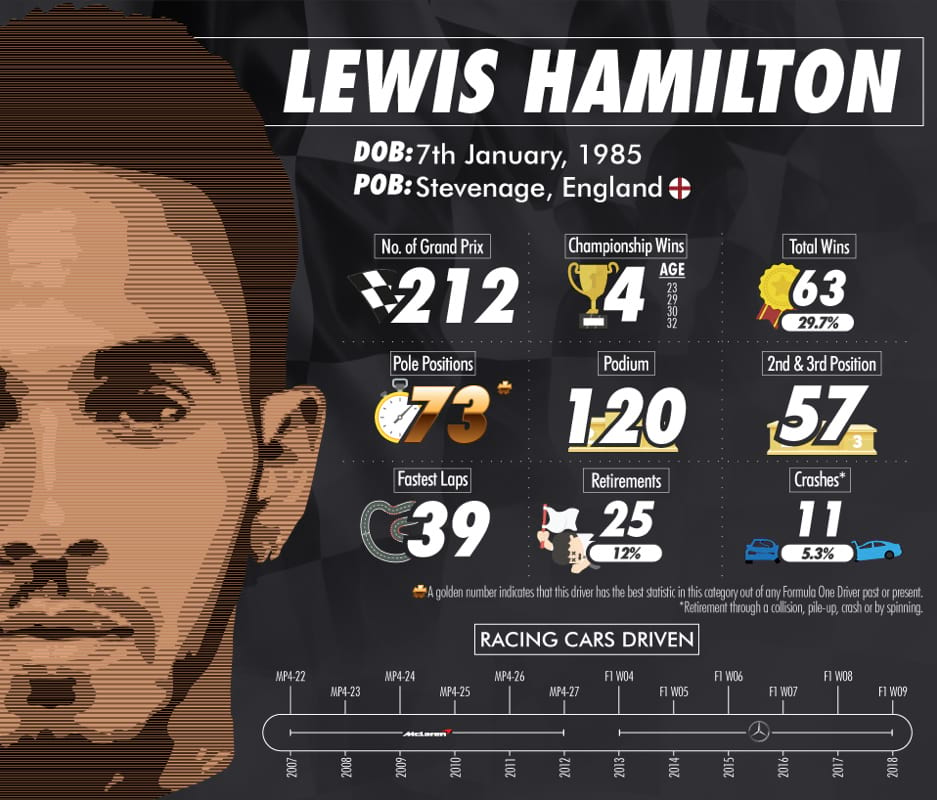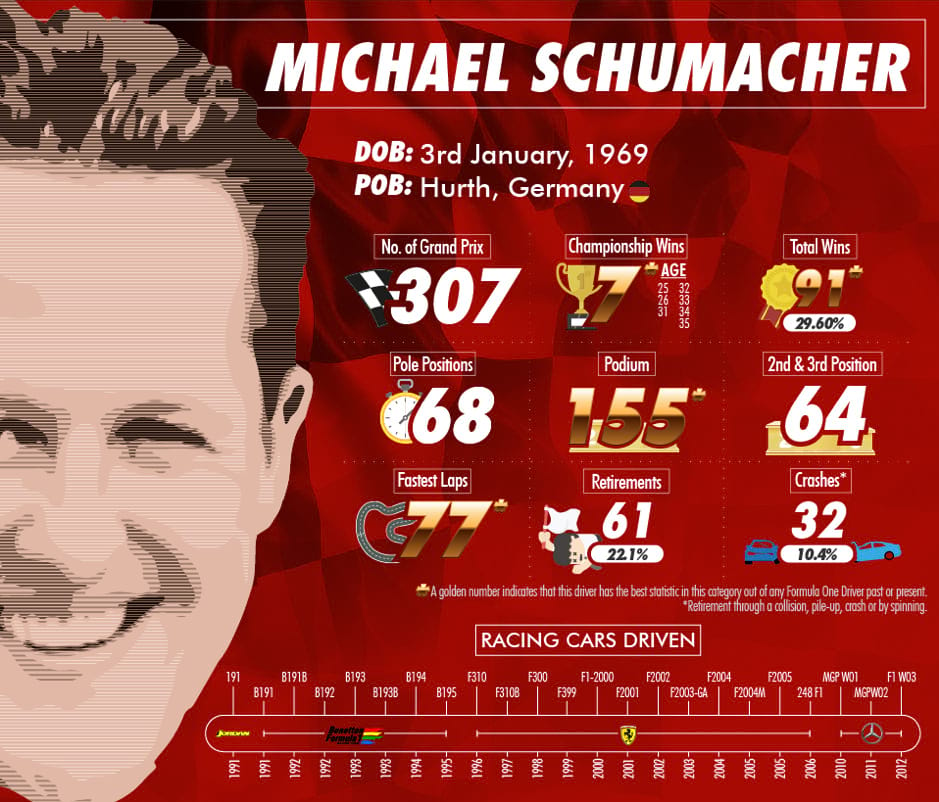There have been many wildly successful Formula One drivers over the years – Senna, Hamilton, Vettel, Lauda, Schumacher… to name just a few!
But who is the most successful of them all? A difficult question to answer. And of course, before you can work out who is the most successful driver you need to first define success. For instance:
- Is it down to the number of championship wins?
- Number of race wins?
- Win percentage?
- Number of fastest laps?
- Are being the most successful and being the greatest the same thing?
Clearly there are a variety of factors by which we can measure a driver’s success, but no single factor can define success by itself. So, enough with the half-baked theories and never-ending debates. In this list we’ve collated the most important statistics, looking specifically at drivers who have competed in 50 Grand Prix’s or more throughout history, to come to the internet’s first numerically objective conclusion on who is truly the most successful Formula One driver of all time…
If you don’t have time to read this study, you can see the full list of the most successful drivers HERE.
Highest Wins in Career
| Driver | No. of Grand Prix | Total Wins |
|---|---|---|
| Michael Schuhmacher | 307 | 91 |
| Lewis Hamilton | 212 | 63 |
| Alain Prost | 199 | 51 |
| Sebastian Vettel | 201 | 49 |
| Ayrton Senna | 161 | 41 |
| Fernando Alonso | 294 | 32 |
| Nigel Mansell | 187 | 31 |
| Jackie Steward | 99 | 27 |
| Niki Lauda | 171 | 25 |
| Jim Clark | 72 | 25 |
This is the first of two sections to be utterly dominated by Michael Schumacher. With a total of 91 wins he is by far and away the highest ranked in this list – the German has 28 more wins than Lewis Hamilton in second, and 66 more than Jim Clark in tenth.
When studied in its entirely, this list is one of two distinct halves. The drivers ranked one to five, by and large, widely spread out. Schumacher, in first, has 50 more wins than Ayrton Senna in fifth. However, when it comes to the drivers ranked lower down the table in positions six to ten, the results are far closer together – as evidenced by Fernando Alonso in sixth and Clark in tenth, despite the former having only 7 more wins than the latter.
Nigel Mansell, who comes in seventh place with 32 wins, also has the dubious record of having the seventh highest number of retirements in all Formula 1 with a total of 92. This shows how close to the edge Mansell must have raced, pushing his car to the very limits of its capabilities.
Two other members on the highest wins list that also rank highly in overall retirements are Niki Lauda, who is in fourteenth place with 80 retirements, and Schumacher, who is twenty-third with 68.
Another driver worth mentioning is Sebastian Vettel, who holds the record for the highest number of consecutive wins. Over the course of 2013 he racked up a total of 9 back-to-back Grand Prix wins, starting in Belgium and ending after Brazil.
Highest Win Percentage
| Driver | No. of Grand Prix | Win Percentage Over Career |
|---|---|---|
| Juan Manuel Fangio | 51 | 47.1% |
| Jim Clark | 72 | 34.7% |
| Michael Schuhmacher | 307 | 29.6% |
| Lewis Hamilton | 212 | 29.7% |
| Jackie Steward | 99 | 27.3% |
| Alain Prost | 199 | 26.6% |
| Ayrton Senna | 161 | 25.5% |
| Stirling Moss | 66 | 24.2% |
| Sebastian Vettel | 201 | 23.4% |
| Damon Hill | 115 | 19.1% |
Juan Manuel Fangio, also known at ‘The Old Man’ or ‘The Maestro’, is the highest-ranking driver in this category, and he is an unusual driver for several reasons. He began entering and winning F1 races at an age far above every other driver in this study, winning his first championship aged 39. He also stands apart by being one of only two drivers in this research to go through just one crash in F1 – although it was by no means a light one. In 1952, he spent the night before a race in Monza driving through the Alps, having missed his connecting flight. He arrived mere minutes before the race began, but his extreme fatigue due to lack of sleep led to a crash on the second lap. His injuries were various – the worst being a broken neck – and, although he had largely recovered by the end of the year, he would have a stiff back for the rest of his life.
Taking a look at the full list, we’re provided with an interesting spread of nationalities. Half of the drivers are British, with the rest being made up of two Germans, a Frenchman, a Brazilian, and of course the Argentine – Fangio.
Jim Clark, the holder of second place with a win percentage of 34.7%, also makes it into the Top ten for number of wins. He surely would have made it even higher in both lists, but his life was tragically cut short in a racing accident aged just 32.
Third place belongs to Schumacher, appearing in this study again.
Most of the drivers on this list are closely grouped together, with ranks three to ten being within 11% of one another. First and second place stand out, with Clark being a whole 5.1% above Schumacher, and Fangio nearly 13% ahead of Clark, leaving a huge gap of 28% between first (Fangio) and tenth (Damon Hill). Evidently, Fangio and Clark stand far above the competition in this respect.
Most 2nd & 3rd Places
| Driver | No. of Grand Prix | 2nd & 3rd Places |
|---|---|---|
| Kimi Raikkonen | 275 | 74 |
| Fernando Alonso | 294 | 65 |
| Michael Schuhmacher | 307 | 64 |
| Rubens Barrichello | 323 | 57 |
| Lewis Hamilton | 212 | 57 |
| Alain Prost | 199 | 55 |
| Sebastian Vettel | 201 | 52 |
| David Coulthard | 246 | 49 |
| Ayrton Senna | 161 | 39 |
| Gerhard Berger | 210 | 38 |
The driver that comes first in the most 2nd & 3rd places list is none other than Kimi Raikkonen who, ironically, came second in his only other entry on this study: number of fastest laps.
Raikkonen’s number of 2nd & 3rd place results, clocking in at 73, far outweighs his 20 wins. Adding his wins and 2nd & 3rd places leaves him ranked fourteenth in a list of drivers ranked in order of number of total podium places, with a total of 93.
Upon seeing the title of this category, one might at first expect it to be the “almost” award – primarily made up of drivers that could be considered second tier. However, the results may surprise you. Of the ten drivers you see here, only three of them – Rubens Barrichello, David Coulthard and Gerhard Berger – haven’t won at least one championship. Barrichello and Coulthard were seen as no. two drivers behind team mates like Schumacher, Jenson Button, Damon Hill and Mika Hakkinen, making it harder for them to win more races.
There are also drivers in this category like Alonso, who came in second in our top ten for this category, but has two championship wins to his name. He also came second in three other championships. Schumacher takes third, ranking highly once more in this study.
Most Pole Positions
| Driver | No. of Grand Prix | Pole Position |
|---|---|---|
| Lewis Hamilton | 212 | 73 |
| Michael Schuhmacher | 307 | 68 |
| Ayrton Senna | 161 | 65 |
| Sebastian Vettel | 201 | 52 |
| Alain Prost | 199 | 33 |
| Jim Clark | 72 | 33 |
| Nigel Mansell | 187 | 32 |
| Nico Rosberg | 206 | 30 |
| Juan Manuel Fangio | 51 | 29 |
| Mika Hakkinen | 161 | 26 |
A strong driver in this study, Hamilton appears in the top ten of various other categories in our study, including Highest Wins, Highest Win Percentage, Most 2nd & 3rd Places, and Fastest Laps. He even manages to place within the top five of every list in which he’s found. However, the only list he tops (at the moment) is Most Pole Positions, with a total of 73.
Hamilton holds a couple of other records related to pole positions: in 2007 he managed six, giving him the record for the highest number of pole positions in a debut season. As well as this, he shares with Schumacher the highest number of wins from pole position, with a total of 40.
The full list of results is primarily made up of two groups. The top three places are very close to one another: with 73 pole positions Hamilton comes in first place while Schumacher is just behind with 68, who is in turn closely followed by Senna with 65. At the other end of the list, places five to ten are similarly close together. Alain Prost and Jim Clark are joint 5th with 33, while Mika Hakkinen, in tenth place, is only 7 poles behind them with 26. The loner of the list is Vettel, who sits between the two groups in fourth with 52 pole positions.
Senna also stands out for an interesting record – he holds both first and second place for the highest number of consecutive pole positions. Trailing just behind him for this record in third is Prost, his famous rival, and in fourth is, predictably, Schumacher. As Senna’s career was tragically cut short by his fatal racing accident, we’ll never know how much more success he could have gone on to have.
Most of the drivers here reach triple digits with their number of Grands Prix races (the lowest of them are Senna and Hakkinen with 161). The exceptions to this are Clark and Fangio, who most remarkably managed to make it on this list despite entering in far fewer Grands Prix than the other eight drivers. Clark entered 72 races, with 33 poles, while Fangio entered just 51 races, getting pole position in 29 of them.
Fastest Laps Over Career
| Driver | No. of Grand Prix | Fastest Laps |
|---|---|---|
| Michael Schuhmacher | 307 | 77 |
| Kimi Raikkonen | 274 | 45 |
| Alain Prost | 199 | 41 |
| Lewis Hamilton | 212 | 39 |
| Sebastian Vettel | 201 | 33 |
| Nigel Mansell | 287 | 30 |
| Jim Clark | 72 | 28 |
| Mika Hakkinen | 161 | 25 |
| Niki Lauda | 171 | 24 |
| Juan Manuel Fangio | 51 | 23 |
This is the second list in which we find Schumacher at the top. With 77 fastest laps he is far ahead of the other 9 drivers, beating second place by a massive 32.
Much like the number of pole positions, most of the ranks are taken up by drivers with a high number of Grands Prix logged. Five out of the ten drivers entered at least 200 or thereabouts (Prost clocks in at 199). Three more of the drivers are well into triple digits in this regard – Mansell has 187, Lauda has 171, and Hakkinen has 161. The exceptions are Clark and Fangio once again, who entered far fewer Grands Prix than their competitors, yet still make it on this list.
The high standard of driving is self-evident in this category, with every driver in the top ten having won the World Championship at least once.
Lowest Crash Percentage Over Career
| Driver | No. of Grand Prix | Crash % |
|---|---|---|
| Stirling Moss | 66 | 1.5 |
| Juan Manuel Fangio | 51 | 2.0 |
| Valtteri Bottas | 97 | 2.1 |
| Daniel Ricciardo | 129 | 2.3 |
| Dan Gurney | 86 | 2.3 |
| Carlos Reutemann | 146 | 2.7 |
| Jim Clark | 72 | 2.8 |
| Emerson Fittipaldi | 144 | 3.5 |
| Denny Hulme | 112 | 3.6 |
| Richie Ginther | 52 | 3.8 |
This list is primarily made up of drivers born before 1950. The two exceptions are Valtteri Bottas and Daniel Ricciardo, both of whom are much younger, born in 1989. These results are arguably due to there being fewer races per year when the older generation were racing, while the two younger drivers have entered far fewer races than their contemporaries due to their youth, and thus have been involved in less situations that could lead to a crash. However, the races and cars of today are also far more safety conscious, so the fact that some of these older drivers managed to make it through their whole careers with little to no crashes, is very impressive.
The driver with the lowest crash percentage is the British Stirling Moss, totalling at a 1.5% crash rate in his career. His one major Formula 1 accident occurred while he was practicing for the Belgian Grand Prix. While it left him seriously injured and unable to take part in the next three races, he had recovered enough by the end of the season to come first in the US Grand Prix.
The only other major crash of Moss’ career happened outside of Formula One in 1962; he was in a coma for a month and the left side of his body was partially paralysed for six months. Moss retired from racing after he recovered, having concluded that his skills had permanently deteriorated due to the accident.
The one driver on the list to be killed in a crash was Jim Clark. However, the fatal crash isn’t one of the accidents listed here – it took place during a Formula 2 race in 1968.
So, Who is Formula One’s Most Successful Driver?
| Driver | Final Score |
|---|---|
| Michael Schuhmacher | 8.38 |
| Lewis Hamilton | 7.04 |
| Juan Manuel Fangio | 5.94 |
| Sebastian Vettel | 5.87 |
| Alain Prost | 5.67 |
| Ayrton Senna | 5.17 |
| Jim Clark | 4.73 |
| Jackie Steward | 4.29 |
| Fernando Alonso | 3.80 |
| Niki Lauda | 3.62 |
After collating all the data that we deemed made a successful driver, we used a formula to normalise each statistic. This allowed us to measure the drivers against each other in each category out of ten. We then took these results and condensed them into a single average for each driver, allowing us to numerically rank them based on everything we’ve shown you. It is also important to note that we weighted the categories according to what we thought was more relevant in relation to the concept of success, and also to balance out the fact that some drivers have had vastly more races. This brought each of the drivers onto more of a level playing field.
If you’d like to see the full table of data, you can do so HERE.
Being a great driver and being successful are different things: the former is an internal and theoretical potency for brilliance, while the latter is a more quantifiable case of getting results. What we mean by this is, that a great driver can have all the skill, technical and racing ability, but if they don’t have the right team, car, engine and even luck, it will harm how successful they can actually be.
Our results were fascinating. Coming in at number one was a driver who has featured and won multiple categories in our study, with an average of 7.45 out of 10, he stormed take to first place as the Most Successful Formula 1 Driver of All Time, the one and only Michael Schumacher. While most people probably saw this coming, what’s truly outstanding about this result is that even though he has by far and away the highest amount of crashes of the top ten, Schumacher is still ahead of the competition, comfortably retaining first place. This indicates just how on the edge Schumacher would race, often getting himself into trouble due to his competitive nature, the Damon Hill incident in the Australian GP of 1994 springs to mind.
The second place is similarly predictable. While not as supremely high ranking as Schumacher, Lewis Hamilton reliably maintains a strong average in every statistic, giving him a final result of 7.07 out of 10. Similar to the dominance of Ferrari in Schumacher’s day, Mercedes have dominated recent years to the point of it not even being competitive. Whilst this year looks to be different, this has certainly added to Hamilton’s incredible success over the past few years. He still does have a long way to go before he can overtake Schumacher, but Hamilton has only been racing in Formula One for 12 years while Schumacher stopped after 19 years – if can maintain his high standard of driving for the foreseeable future, could Hamilton one day become the most successful driver? Only time will tell.
The wonderful Juan Manuel Fangio takes third place; an understandable result considering his incredible win percentage as well as his other various appearances throughout this study. A UNIVERSITY STUDY tried to find out who was the best driver regardless of teams and cars, and found him to be their number one. He was a driver of supreme skill and it would be fascinating if we could match him up against the drivers of today. We’re sure that he would still be right at the very top of the sport.
In regard to the rest of the top ten, the list is made up of mainstays we’ve already encountered throughout this study. The high rankings of Ayrton Senna and Jim Clark in the top ten list are impressive, and makes you wonder what heights they could have reached were it not for their untimely deaths in their early 30s.
So there you have our top ten list of The Most Successful F1 Drivers of All Time. Do you agree with our criteria for success and the results they gave us? Or do you think there are other factors that should be taken into consideration?
Driver Fact Files
So, with these tables it can be hard to get a rounded view of the drivers and their careers. We have picked out some of the winners of the categories and looked at them a little more in depth.















